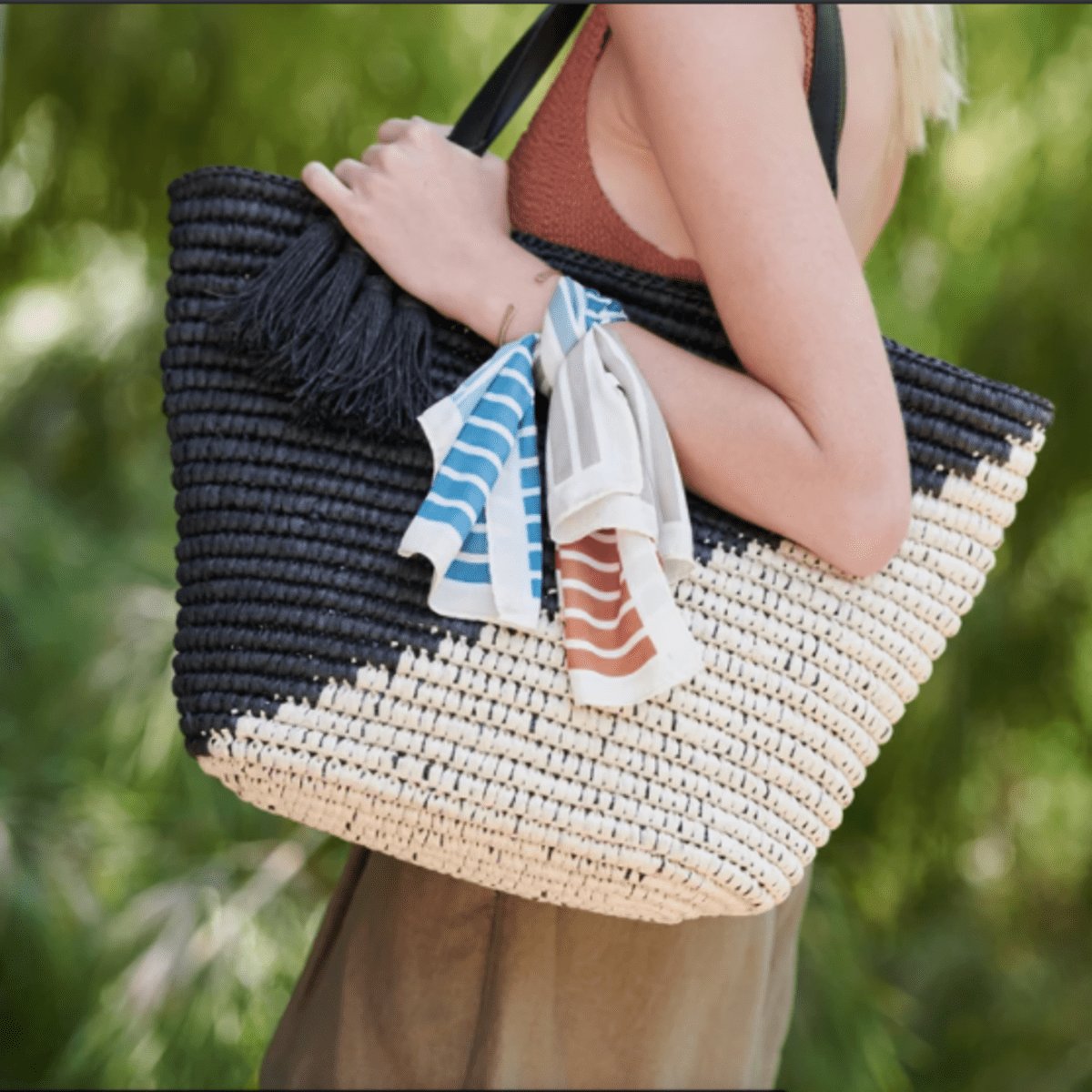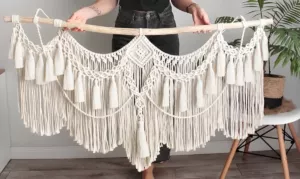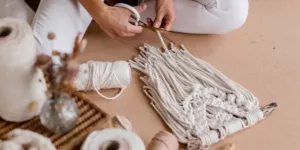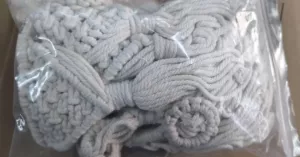Hand woven tote bags are a distinctive and artisanal choice in the world of accessories, characterized by their craftsmanship and the unique qualities imparted by the hands that weave them. These bags are made using traditional techniques that have been passed down through generations, involving the intricate interlacing of threads or fibers to create durable, functional, and aesthetically pleasing totes. The materials used can vary widely, from natural fibers like cotton, jute, and wool, to synthetic fibers for added durability and strength. Each piece stands as a testament to the skill and dedication of its maker, bearing the hallmarks of handcrafted artistry.
In today’s fashion trends, hand woven tote bags have surged in popularity not just for their stylish appeal, but for the values they embody. They represent a move towards sustainability, ethical production, and support for artisan communities worldwide. In a market saturated with mass-produced items, hand woven tote bags offer a breath of fresh air – each bag is unique, with its own story and character.
Moreover, as consumers become more conscious of their environmental impact and the origins of the products they purchase, hand woven tote bags resonate strongly. They align with the growing preference for eco-friendly, reusable shopping bags, all while providing a fashionable edge. The versatility of these bags, coupled with their eco-credentials, makes them a perfect choice for the fashion-forward yet environmentally conscious shopper.
Thus, hand woven tote bags are not just accessories; they are a statement. They bridge the gap between tradition and modern style, bringing forward the importance of craftsmanship in an increasingly automated world. Their importance and relevance in today’s fashion trends underscore a collective desire for products that are not only beautiful but are imbued with meaning, sustainability, and a human touch.
Origin and History of Hand Woven Tote Bags
Before we became acquainted with the stylish and practical hand woven tote bags we know today, the original forms of these bags have roots that extend far back into human history. The skill of weaving is one of the oldest known to mankind. It emerged as a direct necessity of life, primarily for creating functional items such as clothing, shelters, and yes, bags.
Originally, people living in ancient civilizations would weave bags from naturally available materials. They used plant fibers, animal hair, and even thin strips of leather. The techniques varied based on geographic location and available resources, leading to a diverse range of bag styles. In many cultures, these bags served numerous purposes – from carrying food and provisions during hunting and foraging, to functioning as storage vessels or even status symbols in certain societies.
In Native American cultures, for example, weaving was a highly respected craft and woven bags were decorated with intricate designs and motifs to reflect tribal stories and beliefs. Similarly, in parts of Africa and Asia, hand-woven bags were made using techniques like twill and coiling, with each region showcasing patterns and sophistication unique to their heritage.
Over time, these local and indigenous weaving practices evolved and converged with modern fashion trends, leading to the rise of the contemporary hand woven tote bag. These bags retain the traditional craft of hand weaving, but incorporate aspects that cater to modern lifestyle needs.
Overall, the evolution of hand woven tote bags reflects not just shifts in fashion, but the integration of long-standing traditions with contemporary design. Today’s tote bags offer better durability, diversity in materials used, and more intricate designs that cater to a variety of tastes and preferences. They maintain the spirit of their historical predecessors and adapt it to the needs and sensibilities of the modern user, resulting in a product that is both deeply rooted in tradition and fitting for the present day.
How Hand Woven Tote Bags are Made
Hand woven tote bags are made from a wide array of materials, each selected for qualities such as durability, aesthetics, and environmental impact. Commonly used materials include:
- Natural Fibers: These include cotton, jute, sisal, and wool, all chosen for their strength, eco-friendliness, and biodegradability. Cotton provides softness and versatility, jute offers robustness, sisal is appreciated for its texture and durability, and wool brings warmth and a unique soft texture.
- Synthetic Fibers: Polyester and nylon are sometimes incorporated for additional strength, water resistance, and color longevity. These materials can enhance the bag’s durability and make it more suitable for a variety of weather conditions.
- Recycled Materials: With a growing emphasis on sustainability, recycled plastics, and repurposed fabrics are also being utilized. These materials reduce waste and environmental impact, aligning with eco-conscious production ethics.
- Blended Materials: Often, materials are blended to achieve the best of all worlds – durability, texture, and eco-friendliness. For instance, a cotton-jute blend can offer the softness of cotton with the ruggedness of jute.
Description of the Process and Craftsmanship Involved in Hand Weaving
The process of hand weaving tote bags is intricate and requires a high degree of craftsmanship. Here’s an outline of the key steps involved:
- Preparation of Materials: The first step involves preparing the chosen materials. Natural fibers might be spun into yarns, while synthetic or recycled materials are cut into strips or threads.
- Setting Up the Loom: Weaving is generally done on a loom. The loom’s size and type can vary based on the weaver’s preference and the specific technique being used. Setting up involves affixing the warp threads (the threads that run lengthwise) onto the loom, a process known as warping.
- Weaving: The actual weaving process involves interlacing the weft threads (the threads that run widthwise) with the warp threads using a variety of techniques. This can be a simple over-and-under weave or involve more complex patterns. The weaver’s skill determines the tightness of the weave, the consistency of the pattern, and the overall integrity of the bag.
- Adding Features and Finishing Touches: Once the basic body of the bag is woven, additional features such as linings, zippers, handles, or decorative elements might be added. These can be sewn in or affixed using other methods, and they often require additional skills in sewing or leatherwork.
- Finishing: The final step involves finishing touches like trimming any excess threads, adding protective coatings if necessary, and sometimes even ironing or pressing the bag to ensure it holds its shape.
The craftsmanship involved goes beyond just the act of weaving. It encapsulates the selection of materials, the preparation of the loom, the actual interlacing of threads, and the addition of elements that turn a simple piece of fabric into a functional, elegant tote bag. Each hand woven tote bag is a reflection of the weaver’s dedication, skill, and aesthetic sensibility, making each piece uniquely valuable.
Types of Hand Woven Tote Bags
Hand woven tote bags come in a myriad of styles and designs, each reflecting a blend of traditional techniques and contemporary aesthetics. The diversity encompasses shapes, sizes, color palettes, patterns, and additional design elements like handle types, closures, and adornments.
Traditional Styles: Traditional tote bags often lean into the roots of their specific weaving traditions. For instance, designs from Native American cultures might incorporate intricate geometric patterns or use materials like wool or leather, with earth-tone color palettes. African styles could highlight the usage of materials like grass or sisal and incorporate traditional motifs or symbols into their design. Asian designs might leverage bamboo or silk, emphasizing unique weaving patterns.
Contemporary Styles: These styles bring the weaving tradition into the modern age. They retain the hand-woven texture but incorporate contemporary color palettes, like neutrals for versatility or bright and bold colors for accent pieces. They might use alternative materials like recycled plastic strips or modern blends. Shapes and sizes become more varied, from oversized bags for beach getaways to small totes for daily errands. And they often include modern features like zipped compartments, sturdy handles, printed linings, and other functional details.
Examples of Traditional and Contemporary Variations
1. Traditional Mexican Tote Bags: Known as “Bolsas,” these bags typically feature a tight weave, bright colors, and are commonly made from palm fronds. They often bear bold, geometric patterns passed down through generations.
2. African Kiondo Bags: Hand woven by the Kikuyu and Kamba tribes in Kenya, these bags are often created from sisal fibers and decorated with beads or dyed yarn to create distinct patterns. They are renowned for their durability and ethically sourced materials.
3. Balinese Ate Grass Bags: Known for their intricate weave and circular shape, these bags were traditionally used for temple offerings. They are now popular fashion items favored for their uniqueness and craftsmanship.
4. Contemporary Jute-Cotton Bags: These bags exhibit modern simplicity. They often feature clean lines, neutral colors, and leather handles. They are sturdy, functional and stylish to cater to a variety of fashion tastes.
5. Recycled Plastic Tote Bags: These represent the evolution of the weaving tradition towards sustainability. They maintain traditional weaving patterns, but use recycled plastic strips in bright colors or sophisticated neutrals.
Each form – traditional or contemporary – brings its own charm, making hand woven tote bags a versatile accessory that resonates with a wide range of users. The sheer variety ensures that everyone can find a tote bag that aligns with their aesthetic preferences, functional needs, and ethical values.
Benefits and Features of Hand Woven Tote Bags
Hand woven tote bags are revered not just for their aesthetic appeal but for their remarkable durability and strength. The quality of craftsmanship that goes into each piece ensures that the bags can withstand the rigors of daily use, often outlasting mass-produced alternatives. The interlocking of threads or strips of material in the weaving process creates a sturdy fabric that can bear significant weight. Moreover, the materials chosen for these bags—be it natural fibers like jute, cotton, and sisal, or synthetic ones like nylon—further contribute to their robustness. Some weavers also utilize techniques such as double weaving or reinforcing stitching at stress points to enhance the bag’s capacity and longevity.
Environmental Benefits
Hand woven tote bags align well with eco-friendly practices due to several key factors:
- Reusability: These tote bags are built to last, promoting a culture of reuse and significantly reducing the reliance on single-use plastic bags that populate landfills.
- Sustainable Materials: Many tote bags are made from natural, biodegradable fibers or recycled materials, minimizing the environmental footprint from production to eventual disposal. The preference for locally sourced materials in traditional weaving practices also lowers transportation emissions.
- Low Waste Production: The hand weaving process is inherently low waste, as makers can control the amount of material used with precision and repurpose any leftovers for smaller projects, reducing the volume of production waste.
Versatility in Function and Style
The wide array of styles, designs, and sizes of hand woven tote bags makes them incredibly versatile accessories that cater to a range of uses and aesthetic preferences.
- Function: From groceries to beach essentials, gym gear, or daily personal items, these bags can carry it all. Specialized designs may even feature compartments or pockets for additional organization, making them practical for students, professionals, and anyone in between.
- Style: Whether it’s a traditional pattern that pays homage to a particular culture or a contemporary design that fits seamlessly into modern wardrobes, there’s a hand woven tote for every taste. They can be statement pieces that add a pop of color or texture to an outfit or understated accessories that complement any look.
- Adaptability: The adaptability of hand woven tote bags extends beyond their function and style. They fit into various settings, from casual outings and shopping trips to more formal events, depending on the design and materials used. The social and environmental consciousness surrounding hand woven bags also aligns them with current trends towards sustainability in fashion.
In summary, the durability, environmental benefits, and versatility in function and style make hand woven tote bags not just practical accessories but also meaningful investments towards a more sustainable, fashionable future.
Styling Tips for Hand Woven Tote Bags
Casual Outings:
- Outfit: Pair a brightly colored hand woven tote with denim jeans, a white T-shirt, and comfortable sneakers for a relaxed, everyday look.
- Occasion: Ideal for running errands, a casual brunch, or a stroll in the park.
Beach Day:
- Outfit: Use a large hand woven bag made from straw or sisal with your swimwear, an airy kaftan, wide-brimmed hat, and flip-flops.
- Occasion: Perfect for carrying towels, sunblock, and a good book to the beach.
Work or School:
- Outfit: A sturdy jute-cotton tote with leather handles pairs well with tailored trousers or a pencil skirt, a blouse, and loafers or pumps.
- Occasion: Suitable for carrying a laptop, notebooks, and other essentials to the office or college.
Evening Events:
- Outfit: Choose an elegant, smaller hand woven bag to go with a cocktail dress or a chic jumpsuit and heeled sandals.
- Occasion: Appropriate for dinner parties or evening receptions where a touch of handcrafted sophistication adds to your ensemble.
Travel:
- Outfit: A durable and spacious tote bag complements travel attire like leggings or joggers, a comfy sweater, and sneakers or boots.
- Occasion: Works great for weekend getaways, road trips, or as a carry-on bag for flights.
Tips for Maintaining and Cleaning Hand Woven Bags
- General Care:
- Store your bag in a dry, well-ventilated space when not in use.
- Use a soft brush to remove surface dirt and dust from the weave regularly.
- Avoid overfilling your bag to maintain its shape and prevent stretching or tearing.
- Spot Cleaning:
- Address spills and stains quickly but gently. Blot (don’t rub) the affected area with a damp cloth.
- Test any cleaning product on an inconspicuous area first to ensure it doesn’t damage the material or colors.
- Washing:
- Check the care label or consult the maker for specific instructions. Many hand woven fabrics can be sensitive to water or chemicals.
- If the bag can be washed, use cold water and a gentle detergent. Hand wash without vigorous scrubbing and rinse thoroughly.
- Drying:
- Air dry your bag by hanging it or laying it flat in a shaded area, keeping it out of direct sunlight to prevent fading or warping of natural fibers.
- Dealing with Odors:
- If your bag cannot be washed, baking soda can be used to absorb odors. Sprinkle some inside, leave it overnight, and shake it out the next day.
- Preserving Shape:
- When storing your bag for an extended period, stuff it with clean paper or fabric to help maintain its shape and prevent creases or folds.
- Professional Care:
- For difficult stains or materials like leather, consult a professional cleaner who has experience with handcrafted items.
By following these tips, your hand woven tote bag will remain a cherished part of your wardrobe, maintaining its functionality and unique beauty for years to come.
Why Invest in Hand Woven Tote Bags
Investing in hand woven tote bags is not simply about owning another item; it’s a commitment to quality, individuality, and ethical consumerism. Here’s why you might consider adding a hand woven tote bag to your collection:
Unmatched Uniqueness
Every hand woven bag stands out due to the inherent singularities of the hand weaving process, which guarantees that no two bags are identical.
- One-of-a-Kind Designs: The variations in weave, color, and pattern are reflections of the artisan’s personal weaving process, ensuring each bag has its own character.
- Textures and Materials: The use of natural materials adds unique textural elements that machine-made bags cannot replicate.
- Imperfect Perfection: The slight asymmetries and irregularities are not flaws but rather hallmarks of handcrafted authenticity, valued for their raw beauty.
Supporting Artisans and Traditional Craftsmanship
Choosing to purchase a hand woven tote bag has a ripple effect beyond the aesthetics of the accessory, promoting social and cultural values.
- Empowerment Through Trade: Your investment helps sustain the livelihoods of the artisans, often in regions where such skills are economically vital.
- Skill Preservation: When you buy a handcrafted tote, you vote with your dollars to keep ancient crafts alive, passing down invaluable techniques from one generation to the next.
- Cultural Celebration: Handwoven patterns and styles are expressions of cultural identity and history. Buying these bags honors and helps preserve this artistic diversity.
- Supporting Sustainability: Artisans typically utilize locally-sourced and eco-friendly materials, making hand woven tote bags an environmentally conscious choice.
Conclusion
Hand woven tote bags stand as a testament to the union of tradition, craft, and modern style. Holding one in your hands is akin to holding a piece of history, culture, and the impeccable skills and creativity of an artisan weaver. The bags offer an unbeatable uniqueness as they are interwoven with intricate designs, patterns and are often marked by delightful irregularities that add to their charm.
In addition to being a valuable accessory, the handwoven tote bags go beyond mere aesthetics. Investing in these bags significantly contributes to the empowerment and preservation of the artisan communities, ensuring their age-old techniques and craftsmanship continue to thrive in an era of mass-produced fashion.
Moreover, the bags embody earth-friendly practices with their locally sourced, often biodegradable materials, countering the fast fashion industry’s damaging environmental footprint. Your tote bag purchase, therefore, is not just an addition to your wardrobe, but a conscious choice to promote sustainability.
In conclusion, owning a hand woven tote bag provides a sense of satisfaction that goes beyond owning a unique, stylish accessory. It becomes a symbol of your support for traditional art forms, cultural preservation, ethical consumerism and sustainable fashion. It is indeed an ideal blend of tradition, artistry, and style—an art piece to wear and cherish for years.









